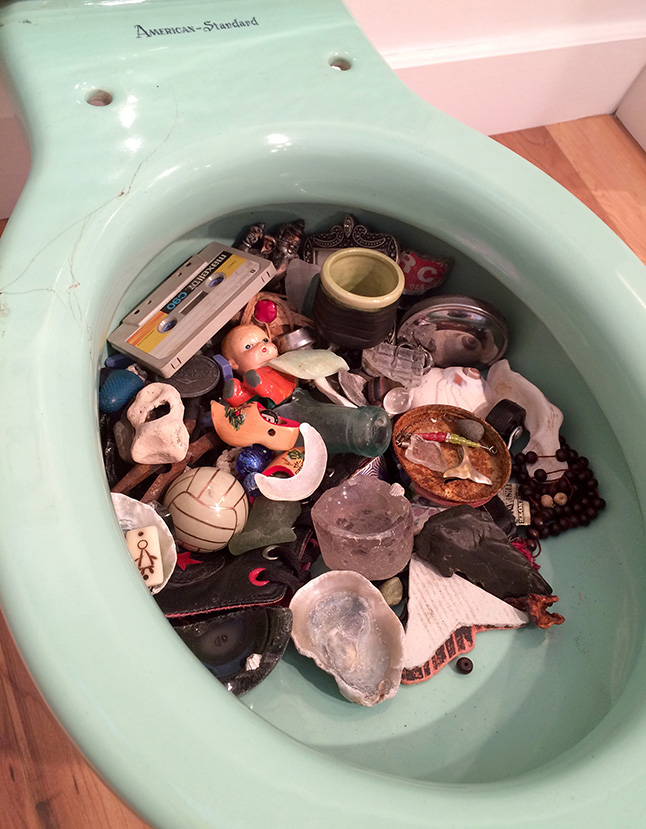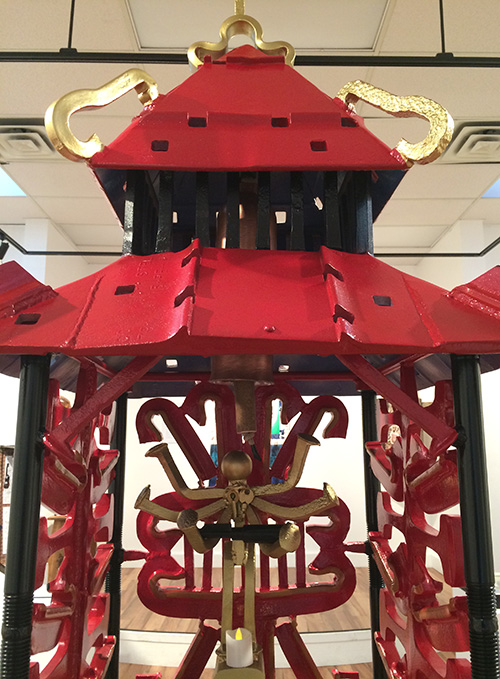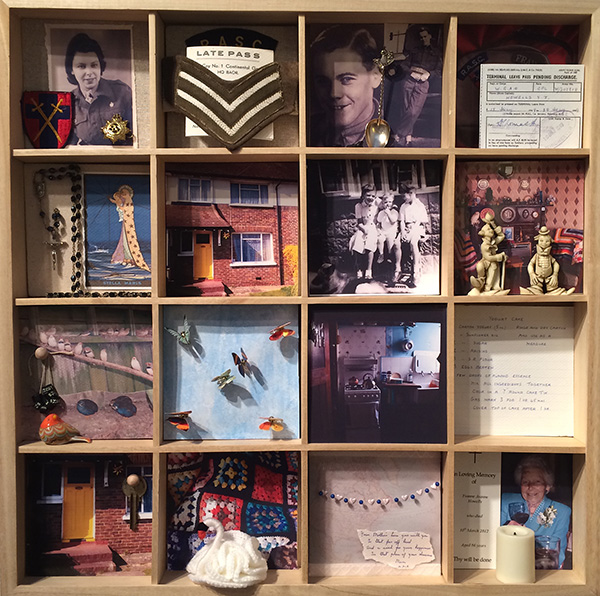By Victoria Strange
As I stand in the entry with a veil of silk curtains before me, I am eager to view the current exhibit at the Revelstoke Art Gallery. There is no doubt in my mind that behind the wall of secrecy lay an eclectic and powerful exhibit. Curated by Krista Stovel and Jacqueline Pendergrast, Shrines, Altars and Curiosities is a hand-picked members’ show of 15 artists. And so I gently part the curtains and step through to the other side.
Immediately, I’m confronted with a bold and imposing sculpture constructed of railway scrap painted bright red and gold. Andrew Stacey’s Railway Shrine is a homage, not only to Stacey’s own personal history with the railway (he was a conductor and engineer for over a decade), but to the fabric of the city itself. The relationship is clear, and perhaps for a moment, too obvious. But as I step back and look at the sculpture in relation to the entire exhibition, it is evident that the work extends beyond itself. It seems to act as a beacon within the gallery, and I’m curious as to whether Stacey’s sacred shrine is for celebration, or intended as a warning signal.
My eyes are then drawn to the corner of the room where a most unique altar sits. There is no doubt what it is, and while I quickly try to suppress thoughts of Marcel Duchamp’s 1917 urinal, I approach Estée Sylvester’s piece titled Bottom’s Up. The mint green toilet filled with mementos such as a doll’s head, old mixed cassette tape, and shells, sits squarely under a painting which loosely depicts plumbing. There is initially a comedic presence to this work, but my desire to chuckle is tempered by thoughts of all the disgusting offerings toilets accept. A quick turn over my shoulder, and Stacey’s Railway Shrine reminds me of the over-arching concept of this exhibition. I suddenly feel humbled in front of Sylvester’s porcelain altar, slightly ashamed of my disrespect. The artist statement keeps a humorous tone, yet for me, it is contradictory to the elements which fill the basin. I can only assume Sylvester is well aware of the discordant messages her installation presents and the success of her piece to evoke multiple emotions in her viewers.
While some artworks in the exhibit make social statements, like David Walker’s Tech Homage (Leave Your Device at the Door), others, such as Jacqueline Pendergrast’s Homage are deeply personal, exploring lost ancestry and family secrets. Referencing 17th century cabinets of curiosities, Pendergrast’s modern day version is presented in a controlled and cohesive way. It avoids any macabre elements one would expect in historical times, yet the attempts to rationalize and organize information remains. Pendergrast has collected and cataloged her own version of wondrous, personal and beloved objects. The artist’s statement feels like an extension of the artwork rather than a reference, and I find myself going back and forth between the text and the objects, mimicking what I imagine was the artist’s passionate search for meaning within her own story.
I finish the exhibition feeling contemplative. The installations have been constructed knowingly for public consumption, yet I can’t help but feel I’ve invaded these artist’s sacred shrines, taking away an intimate part of them. Before passing back through the curtains, I turn around for one final look. The beacon stares back.
Here are images of some of the works discussed in this article:


Altars, Shrines and Curiosities is on view until November 27 at the Revelstoke Visual Arts Centre at 310 Wilson Street.
Victoria Strange is a new resident of Revelstoke. Raised in Ontario, she is a graduate of the Nova Scotia College of Art and Design in Halifax and has a BEd from Mount Saint Vincent University in Halifax.. Until moving here two months ago Ms. Strange was the co-owner and director of Gallery Page and Strange. She will be commenting about local arts and culture for The Current on a regular basis.



